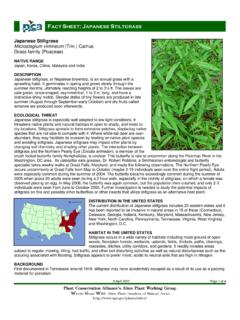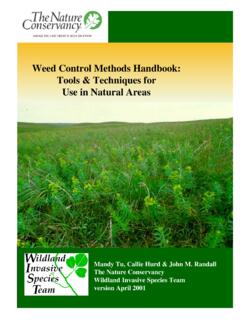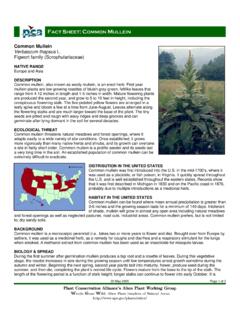Transcription of Plant Invaders of Mid-Atlantic Natural Areas
1 1 Plant Invaders ofMid-AtlanticNatural AreasRevised & Updated with More Species and Expanded Control GuidanceNational Park Fish and Wildlife Service2 INCHES1 Plant Invaders of Mid-Atlantic Natural Areas , 4th SwearingenNational Park ServiceNational Capital RegionCenter for Urban Ecology4598 MacArthur Blvd., , DC 20007 Britt Slattery, Kathryn Reshetiloff and Susan Fish and Wildlife ServiceChesapeake Bay Field Office177 Admiral Cochrane , MD 21401 CitationSwearingen, J., B. Slattery, K. Reshetiloff, and S. Zwicker. 2010. Plant Invaders of Mid-Atlantic Natural Areas , 4th ed.
2 National Park Service and Fish and Wildlife Service. Washington, DC. edition, 20022nd edition, 20043rd edition, 20064th edition, 20102 AcknowledgementsGraphic Design and LayoutOlivia Kwong, Plant Conservation Alliance & Center for Plant Conservation, Washington, DCLaurie Hewitt, Fish & Wildlife Service, Chesapeake Bay Field Office, Annapolis, MDAcknowledgementsFunding provided by the National Fish and Wildlife Foundationwith matching contributions by:Chesapeake Bay FoundationChesapeake Bay TrustCity of Bowie, Maryland Maryland Department of Natural ResourcesMid- atlantic Invasive Plant CouncilNational Capital Area Garden Clubs Plant Conservation AllianceThe Nature Conservancy, Maryland DC Chapter Worcester County, Maryland, Department of Comprehensive PlanningAdditional Fact Sheet ContributorsLaurie Anne Albrecht (jetbead)Peter Bergstrom (European watermilfoil)Kathy Bilton (nodding star-of-Bethlehem)Meghan Fellows (yellow archangel)Richard Hammerschlag & Brent Steury (marsh dewflower)
3 Kerrie Kyde (wavyleaf basketgrass)Roy Miller (hydrilla)Michael Naylor (water chestnut)Kathryn Reshetiloff (Japanese honeysuckle, white mulberry, sawtooth oak, common periwinkle)Rod Simmons (broadleaf helleborine)Julie Slacum (privets)Edith Thompson (butterflybush, Japanese silver grass, daylily)Mary Travaglini (linden viburnum)Alan Whittemore (Callery pear)ReviewersPhilip Pannill (control options), Selma Sawaya (general proof-read-ing), John Peter Thompson (various), Joe DiTomaso (ravenna-grass)Cover ImageCommon periwinkle (Vinca minor) by Bill Johnson3 PrefaceContrary to the title, the focus of Plant Invaders of Mid-Atlantic Natural Areas is native biodiversity.
4 Invasive species and habitat destruction, intensified by global climate change, are running neck-to-neck as the leading causes of environmental despoliation and loss of biological diversity worldwide. The ever-expanding human population and associated demand on limited Natural resources are driving this worldwide problem. International trade provides a means to satisfy the great demand for exotic things but has resulted in the introduction of plants , insects and pathogens that are harmful to our environment and human health. Preserving remaining intact Natural habitats, reestablishing native plants , managing overabundant white-tailed deer populations and restoring Natural hydrologic and other conditions are some steps we can take to mend degraded lands.
5 This fourth edition has been updated, expanded and reorganized to provide more information in a more efficient manner. The book now includes information on 80 species (up from 60 previously) and expanded control guidance. A new section called plants to Watch has been added which includes a number of species that may not be widespread but are increasingly catching the attention of ecologists, land managers and others as being invasive in Natural habitats. Native Plant alternatives have been consolidated in a separate the purposes of this manual, the Mid-Atlantic region includes the District of Columbia and the states of Delaware, Maryland, New Jersey, Pennsylvania, Virginia and West Virginia.
6 About 280 exotic Plant species have been identified by experts as being invasive in Natural Areas in this region. A complete list is available from the Invasive Plant Atlas of the united states (see References). As of this printing , the Invasive Plant Atlas shows 1,173 plants having been reported to be invasive in Natural Areas in the This guide should be used as an introduction to invasive plants and the impacts they are having on Natural habitats and ecosystems. plants not included here should not be assumed to be book is dedicated to Gail Sharabi who inspired my first Weed Buster event at Brookside Gardens in Wheaton, Maryland on Columbus Day in 1993.
7 4 Table of ContentsPreface .. 3 Table of Contents .. 4 Introduction .. 7 Aquatic plants Eurasian Water-Milfoil (Myriophyllum spicatum) .. 14 Giant Salvinia (Salvinia molesta) .. 16 Hydrilla (Hydrilla verticillata) .. 17 Parrot-Feather (Myriophyllum aquaticum) .. 19 Water Chestnut (Trapa natans) .. 21 Grasses and Sedges Bamboos (Bambusa vulgaris, Phyllostachys aurea and Pseudosasa japonica) .. 23 Bog Bulrush (Schoenoplectus mucronatus) .. 24 Common Reed (Phragmites australis) .. 26 Japanese Stiltgrass (Microstegium vimineum).
8 28 Wavyleaf Basketgrass (Oplismenus hirtellus ssp. undulatifolius) .. 29 Control Options .. 31 Herbaceous Forbs Beefsteak Plant (Perilla frustescens) .. 36 Canada Thistle (Cirsium arvense) .. 37 Chinese Lespedeza (Lespedeza cuneata) .. 38 Common Daylily (Hemerocallis fulva) .. 40 Dame s Rocket (Hesperis matronalis) .. 41 European Stinging Nettle (Urtica dioica) .. 43 Fig Buttercup (Ficaria verna) .. 44 Garlic Mustard (Alliaria petiolata) .. 45 Ground Ivy (Glechoma hederacea) .. 47 Japanese Knotweed (Fallopia japonica).
9 48 Nodding Star of Bethlehem (Ornithogalum nutans) and Sleepydick (Ornithogalum umbellatum) .. 50 Purple Loosestrife (Lythrum salicaria) .. 51 Spotted Knapweed (Centaurea stoebe ssp. micranthos) .. 53 Control Options .. 55 Shrubs and Subshrubs Amur Honeysuckle (Lonicera maackii) .. 61 Autumn Olive (Elaeagnus umbellata) .. 62 Japanese Barberry (Berberis thunbergii) .. 64 Japanese Meadowsweet (Spiraea japonica) .. 65 Linden Viburnum (Viburnum dilatatum) .. 66 Morrow s Honeysuckle (Lonicera morrowii) .. 68 Multiflora Rose (Rosa multiflora).
10 695 Privets (Ligustrum obtusifolium, L. ovalifolium, L. sinense and L. vulgare) .. 71 Wineberry (Rubus phoenicolasius) .. 72 Winged Burning Bush (Euonymus alatus) .. 73 Control Options .. 75 Trees Callery Pear (Pyrus calleryana) .. 80 Norway Maple (Acer platanoides) .. 82 Paper Mulberry (Broussonetia papyrifera) .. 83 Princess Tree (Paulownia tomentosa) .. 84 Silk Tree (Albizia julibrissin) .. 86 Tree of Heaven (Ailanthus altissima) .. 87 White Mulberry (Morus alba) .. 89 Control Options .. 91 Vines Black Swallow-Wort (Cynanchum louiseae).












